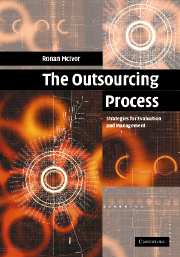Book contents
- Frontmatter
- Contents
- List of figures
- List of tables
- List of illustrations
- Acknowledgements
- 1 Introduction
- 2 The trend towards outsourcing
- 3 Theoretical influences on outsourcing
- 4 The outsourcing process: a framework for evaluation and management
- 5 Determining the current boundary of the organisation
- 6 Activity importance analysis
- 7 Capability analysis
- 8 An analysis of the strategic sourcing options
- 9 Developing the relationship strategy
- 10 Establish, manage and evaluate the relationship
- 11 Case study – outsourcing experiences at Telco
- 12 Conclusions
- Index
- References
5 - Determining the current boundary of the organisation
Published online by Cambridge University Press: 21 August 2009
- Frontmatter
- Contents
- List of figures
- List of tables
- List of illustrations
- Acknowledgements
- 1 Introduction
- 2 The trend towards outsourcing
- 3 Theoretical influences on outsourcing
- 4 The outsourcing process: a framework for evaluation and management
- 5 Determining the current boundary of the organisation
- 6 Activity importance analysis
- 7 Capability analysis
- 8 An analysis of the strategic sourcing options
- 9 Developing the relationship strategy
- 10 Establish, manage and evaluate the relationship
- 11 Case study – outsourcing experiences at Telco
- 12 Conclusions
- Index
- References
Summary
Introduction
This stage in outsourcing evaluation and management is concerned with identifying the major activities that have to be performed in order to create and deliver the range of products and services offered by the organisation to its customers. This involves identifying the major activities that have to be performed internally as well as those performed by external sources. This will provide an outline of the scope of the organisation both upstream into the supply chain and downstream towards end customers of the products and services. In effect, it is concerned with identifying the current boundary of the organisation. Additionally, as will be shown in the following chapters, segmenting the organisation into activities allows an organisation to identify the activities that are a source of competitive advantage, activities in which it is equal to competitors and activities in which it is weaker in relation to competitors. In order to perform this analysis, the resources owned and deployed by the organisation must be identified as well as the activities that have to be carried out so that the organisation fulfils the needs of its customers. A number of frameworks appropriate for activity analysis are presented in this chapter including the value chain, value shop and value network. Analysing the organisation in terms of activities allows outsourcing evaluation to be carried out in a number of contexts including:
an organisation may undertake an evaluation of its entire business and identify potential opportunities for outsourcing from this analysis;
an organisation may select certain parts of the business that it considers as suitable candidates for outsourcing;
[…]
- Type
- Chapter
- Information
- The Outsourcing ProcessStrategies for Evaluation and Management, pp. 90 - 114Publisher: Cambridge University PressPrint publication year: 2005



